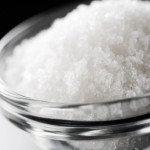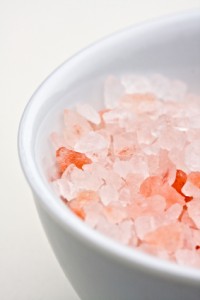 There is quite a bit of talk in the health world about the different types of salt and whether or not they are beneficial for people. The three main types of salt are regular table salt, sea salt and Himalayan Pink Salt.
There is quite a bit of talk in the health world about the different types of salt and whether or not they are beneficial for people. The three main types of salt are regular table salt, sea salt and Himalayan Pink Salt.
Table Salt – This is the most common type of salt found in most grocery stores and restaurants. Most people end up getting too much of this type of salt through processed foods in their diets. This salt is harvested from either underground mines or from sea water. This salt differs from sea salt because it is heavily processed at which time other ingredients are added to it. Part of the processing includes adding anti-clumping agents to the salt which contain high amounts of aluminum. Sugars are added as stabilizers and they also cut the bitter taste of the aluminum.
To help prevent iodine deficiency table salt has added iodine. About 2 billion people worldwide are not getting enough iodine which can lead to mental deficiency. A more natural way of getting iodine is by eating fruits and vegetables grown in iodine rich soil. Including sea vegetables into your diet also provides high amounts of iodine.
Sea Salt – This salt is produced naturally by evaporating away ocean water in man made pools near the shoreline. When the sun and wind have finished evaporating away the sea water the sea salt remains behind for collection. This salt contains over 80 trace minerals. Since this natural salt has no anti-clumping agents it will tend to form clusters in your salt shaker. If this happens to you a mortar and pestle can be used to break down the clusters into fine grains again. It is worth noting that there is a small amount of naturally occurring iodine in sea salt.
 Himalayan Pink Salt – This salt is mined from ancient sea salt deposits in Pakistan and is rich in minerals and trace elements. The salt ranges in colour from white to varying shades of pink to red. Himalayan Pink Salt is believed to be the purest salt available.
Himalayan Pink Salt – This salt is mined from ancient sea salt deposits in Pakistan and is rich in minerals and trace elements. The salt ranges in colour from white to varying shades of pink to red. Himalayan Pink Salt is believed to be the purest salt available.
To stay healthy we only need a small amount of salt in our diet. Sea salt and Himalayan Pink Salt are clearly superior to table salt because they have no additives and they have naturally occurring minerals.
Use your healthy salts sparingly and they can be a great way to bring out the flavours in your favourite recipes.
Let me know in the comments what type of salt is your favourite.
To your health!
Jesse


Thank you for this information. I try to eat healthy and have been wondering the difference between Sea Salt & Himalayan Salt. This was helpful. 🙂
June – You’re welcome… Thanks for the comment! Keep living the healthy lifestyle!
The remedy for clumping natural salt is to drop a piece of sterilized pottery, about 1″x1″ in the shaker. Use a larger shaker filled only 1/2 full/ Get a clump, give it a shake, clump begone. I’d rather have a clump than swallow chemicals best left far away from all living things. And a mortar and pestle does leave one feeling raaather erudite.
Thanks for the tip Harley! Less chemicals = better health.
And, oh, I think Himalayan Pink just has to be the best value for the money. It’s equal in analysis to Celtic Grey, at a fraction of the price. I don’t use a lot of salt, preferring to use Bragg’s Organic Liquid Aminos for general cooking, but I have 20lb of Pink Himalayan in storage, because when the commercial big boys discover it and secure exclusive rights to the source, the quality will be compromised and the price will go through the roof. That’s what I think, anyhow. The experience of what happens to great health brands, Quest, Sisu,Hauser, Yves, Rodale Publications,some green drinks,and so on, when the corporate greed merchants get their claws on them attests to the need to be vigilant. Read ,read , read, those labels. “Natural Flavor,” is a copy righted name of a man made product, manufactured in Sweden, it is not a promise of natural content. They play with the words within legal limits. Fresh squeezed glunk has no flavor when it comes out of those gynormous vats, it is colorless and tasteless, then the “Natural” magic is added. Want extra pulp?? They get that from that special fruit they grow from ancient stock known as extra pulp fruit. It’s then picked by pickers chosen for passing a special code of high ethics board examination, because Corporate World does not allow fibbing.
Thanks for your thoughts, Harley! Wishing you a long and healthy life!
What is the difference an content of Himalayan salt and sea salt? I don’t believe there is much difference except in price.
and murry river salt????
I hadn’t heard of it Lee but I just went on their website and it look legit. Have you tried it?
why is it so difficult to find the answer to this question-how does iodine content compare between iodized salt and pink himalayan salt ?
Probably because the iodized salt is standardized and the Himalayan varies. The darker the color the more it contains. That would be my thoughts on the subject.
Thanks for sharing KCK! I hope one of us can come across at least a range of iodine content in himalayan salt.
Yes Rafael this is frustrating. I did a quick check and didn’t find a thing on himalayan. I’ll let you know if I come across any numbers.
when did you post all this info, because I’m researching for a science fair project and I have to cite your cite-please and thank you.
This was written a long time ago, I don’t recall the sources. Good luck to you Jonathan!
May 8th 2012, good luck to you Jonathan!
Can Himalayan pink salt be subustated for kosher salt in Canning?
Yes definitely 🙂
please let me know the Iodine content in Table salt vs Pink salt.
I don’t have these numbers and I personally don’t rely on salt to get my iodine… I supplement with it. Wishing you all the best!
So in other words Himalayan salt is pink sea salt that was deposited and is now mined.